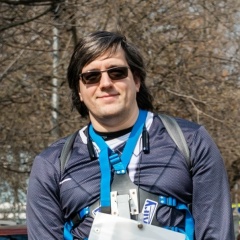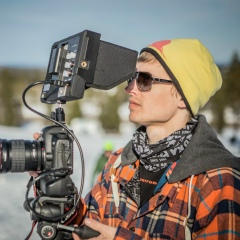29.04.2017
Истоки Волги.
Наутро пошли на разведку в заброшенную деревню. При ближайшем рассмотрении оказалось, что деревня не заброшена, а больше похожа на недостроенную. Встали мы у северного края озера Стерж, третье по счету от истока Волги и первое крупное. На западном берегу есть несколько деревень, Новинка, Алексеевское, Мосеевцы. Немного в стороне от них, на отшибе, совсем на берегу стоит группа из восьми домов. В темноте подумали, что они заброшенные. На свету понятно, что они не были достроены. На бревнах еще видны номера, в оконных проемах никаких следов рам и стекол. Странно, стены стоят, крыши подняли, достроить оставалось совсем немного. Такое ощущение, что это были выселки ближайших деревень, люди пришли, начали строиться, а потом что-то произошло, и все 8 домов разом бросили. Причем дома сравнительно новые, на вид они стоят точно меньше 10 лет. Непонятно…
Около этих выселок стоит памятный крест, причем описание креста достаточно хитрое. Этот крест отмечает одну их вех пути из варяг в греки. Только вот сама веха была в другом месте, и крест поставили тут просто потому, что тут больше потенциальных посетителей. Мне это немного напоминает анекдот, в котором монету искали не там, где потеряли, а там, где фонарь стоял. Оставим это на совести автора креста, тем более что про перенос честно написано.
Походили по непонятным безлюдным выселкам, и поехали к истоку, оставалось меньше 10 км. На въезде в Волговерховье стоит многообещающий знак парковки. Однако на момент нашего визита парковочной площадки как таковой не было – была строительная техника и рабочие, которые что-то ваяли. Место, где должна была располагаться парковка, сейчас представляет собой просто лужу грязи. Там в целом идут масштабные реставрационные работы – обновляют часовню, стоящую непосредственно над истоком, мостки, идущие к ней, церковь вся в строительных лесах. Активно готовятся к туристическому сезону. Сам исток оформлен очень симпатично, часовенка и мостки к ней красивые и вполне уместные. Церквей над истоком стоит целых две, плюс небольшой женский монастырь неподалеку. В общем, это вам не исток Москвы, где стоит одна-единственная часовня (да и та неправильно и не к месту), все-таки великая русская река! Вытекает Волга, как обычно, из болота, и представляет собой ничем не примечательный ручей, перепрыгнуть можно. Теперь могу совершенно честно говорить, что могу одним прыжком через Волгу перемахнуть, проверял!
Налюбовавшись, едем дальше. Следующая остановка – Великий Новгород. Возвращаемся в Свапуще на асфальт, проезжаем полтора километра, и асфальт снова заканчивается. Причем даже не очевидно, станет ли из-за этого сложнее ехать. В конце концов выезжаем снова на асфальтированное шоссе, по нему на север до трассы М10, ну а дальше совсем просто. В Великом Новгороде едем сразу к кремлю, и буквально за пару минут нахожу место для парковки, в пяти минутах ходьбы. В Москве о таком можно только мечтать =) Новгородский кремль сохранился как полноценная крепость. Его до сих пор окружает ров, все стены целые, высокие и внушительные. В самом кремле, как и полагается, музеи, концертный зал, церкви. Но сами музеи нас не интересуют, экспозицию можно и потом в Интернете найти. Нам интереснее погулять и получить общее впечатление. Единственное, хотели зайти в Грановитую палату, но она закрылась минут за десять до нашего прихода, было уже часов 18.
Также зашли на Ярославово Дворище, аккурат на другом берегу Волхова от кремля. Сейчас кремль и Дворище соединяет узкий пешеходный мост. Ранее эти два центра Новгорода, торговый и административный, соединяли более солидные мосты, по которым возили телеги. Согласно Википедии первый мост упоминается аж в 1133 году, и с тех пор мост по необходимости перестраивался и обновлялся. Если кремль сохранился более-менее в своем историческом виде, то от Дворища осталось одно название.
У самого Ярославова Дворища история долгая и сложная. В разное врем там располагалась вечевая площадь, административные здания разных властей, торговые ряды. В советское время торговые ряды разобрали, и сейчас на этом месте просто парк, в котором сохранилось одно из зданий гостиного двора и аж семь разных церквей. Совсем, видимо, в советское время власть церкви не любила =)
Погуляли, и, чтобы зря время не терять, поехали дальше по маршруту, обратно на трассу М10 в сторону Ладожского озера, после Великого Новгорода еще около 100км успел проехать, итого около 360 за день. И вот тут столкнулись с неожиданной проблемой – где встать на ночь. Около Селигера такой проблемы не было – взял, с дороги съехал, и все. Тут с главной трассы тоже съехал, прикинул по спутниковым снимкам где можно будет приткнуться, и ничего не получилось. Места болотистые, и вдоль всех дорог по бокам идут дренажные канавы. Место все-таки нашел, но поискать пришлось изрядно, чуть ли не час крутился. В этот день погода тоже не жаловала, тоже шли дожди, и засыпали под аккомпанемент дождя, барабанящего по крыше.
PS. Фотографирую я все так же на телефон, чудес не будет ????
Истоки Волги.
Наутро пошли на разведку в заброшенную деревню. При ближайшем рассмотрении оказалось, что деревня не заброшена, а больше похожа на недостроенную. Встали мы у северного края озера Стерж, третье по счету от истока Волги и первое крупное. На западном берегу есть несколько деревень, Новинка, Алексеевское, Мосеевцы. Немного в стороне от них, на отшибе, совсем на берегу стоит группа из восьми домов. В темноте подумали, что они заброшенные. На свету понятно, что они не были достроены. На бревнах еще видны номера, в оконных проемах никаких следов рам и стекол. Странно, стены стоят, крыши подняли, достроить оставалось совсем немного. Такое ощущение, что это были выселки ближайших деревень, люди пришли, начали строиться, а потом что-то произошло, и все 8 домов разом бросили. Причем дома сравнительно новые, на вид они стоят точно меньше 10 лет. Непонятно…
Около этих выселок стоит памятный крест, причем описание креста достаточно хитрое. Этот крест отмечает одну их вех пути из варяг в греки. Только вот сама веха была в другом месте, и крест поставили тут просто потому, что тут больше потенциальных посетителей. Мне это немного напоминает анекдот, в котором монету искали не там, где потеряли, а там, где фонарь стоял. Оставим это на совести автора креста, тем более что про перенос честно написано.
Походили по непонятным безлюдным выселкам, и поехали к истоку, оставалось меньше 10 км. На въезде в Волговерховье стоит многообещающий знак парковки. Однако на момент нашего визита парковочной площадки как таковой не было – была строительная техника и рабочие, которые что-то ваяли. Место, где должна была располагаться парковка, сейчас представляет собой просто лужу грязи. Там в целом идут масштабные реставрационные работы – обновляют часовню, стоящую непосредственно над истоком, мостки, идущие к ней, церковь вся в строительных лесах. Активно готовятся к туристическому сезону. Сам исток оформлен очень симпатично, часовенка и мостки к ней красивые и вполне уместные. Церквей над истоком стоит целых две, плюс небольшой женский монастырь неподалеку. В общем, это вам не исток Москвы, где стоит одна-единственная часовня (да и та неправильно и не к месту), все-таки великая русская река! Вытекает Волга, как обычно, из болота, и представляет собой ничем не примечательный ручей, перепрыгнуть можно. Теперь могу совершенно честно говорить, что могу одним прыжком через Волгу перемахнуть, проверял!
Налюбовавшись, едем дальше. Следующая остановка – Великий Новгород. Возвращаемся в Свапуще на асфальт, проезжаем полтора километра, и асфальт снова заканчивается. Причем даже не очевидно, станет ли из-за этого сложнее ехать. В конце концов выезжаем снова на асфальтированное шоссе, по нему на север до трассы М10, ну а дальше совсем просто. В Великом Новгороде едем сразу к кремлю, и буквально за пару минут нахожу место для парковки, в пяти минутах ходьбы. В Москве о таком можно только мечтать =) Новгородский кремль сохранился как полноценная крепость. Его до сих пор окружает ров, все стены целые, высокие и внушительные. В самом кремле, как и полагается, музеи, концертный зал, церкви. Но сами музеи нас не интересуют, экспозицию можно и потом в Интернете найти. Нам интереснее погулять и получить общее впечатление. Единственное, хотели зайти в Грановитую палату, но она закрылась минут за десять до нашего прихода, было уже часов 18.
Также зашли на Ярославово Дворище, аккурат на другом берегу Волхова от кремля. Сейчас кремль и Дворище соединяет узкий пешеходный мост. Ранее эти два центра Новгорода, торговый и административный, соединяли более солидные мосты, по которым возили телеги. Согласно Википедии первый мост упоминается аж в 1133 году, и с тех пор мост по необходимости перестраивался и обновлялся. Если кремль сохранился более-менее в своем историческом виде, то от Дворища осталось одно название.
У самого Ярославова Дворища история долгая и сложная. В разное врем там располагалась вечевая площадь, административные здания разных властей, торговые ряды. В советское время торговые ряды разобрали, и сейчас на этом месте просто парк, в котором сохранилось одно из зданий гостиного двора и аж семь разных церквей. Совсем, видимо, в советское время власть церкви не любила =)
Погуляли, и, чтобы зря время не терять, поехали дальше по маршруту, обратно на трассу М10 в сторону Ладожского озера, после Великого Новгорода еще около 100км успел проехать, итого около 360 за день. И вот тут столкнулись с неожиданной проблемой – где встать на ночь. Около Селигера такой проблемы не было – взял, с дороги съехал, и все. Тут с главной трассы тоже съехал, прикинул по спутниковым снимкам где можно будет приткнуться, и ничего не получилось. Места болотистые, и вдоль всех дорог по бокам идут дренажные канавы. Место все-таки нашел, но поискать пришлось изрядно, чуть ли не час крутился. В этот день погода тоже не жаловала, тоже шли дожди, и засыпали под аккомпанемент дождя, барабанящего по крыше.
PS. Фотографирую я все так же на телефон, чудес не будет ????
04/29/2017
The origins of the Volga.
The next morning we went for reconnaissance in an abandoned village. Upon closer inspection, it turned out that the village was not abandoned, but more like an unfinished one. We got up at the northern edge of Lake Sterzh, the third in a row from the source of the Volga and the first major. On the west bank there are several villages, Novinka, Alekseevskoe, Moseevtsy. A little away from them, on the outskirts, quite on the shore there is a group of eight houses. In the dark they thought they were abandoned. In the light it is clear that they were not completed. The logs are still visible numbers, in the window openings no traces of frames and glass. Strange, the walls are standing, the roofs are raised, there was very little to finish. It seems that these were the settlements of the nearest villages, people came, began to be built, and then something happened, and all 8 houses were abandoned at once. Moreover, the houses are relatively new, they look exactly less than 10 years old. Unclear…
A memorial cross stands near these settlements, and the description of the cross is rather cunning. This cross marks one of their milestones from the Varangians to the Greeks. Only now, the milestone itself was in another place, and they put an end to it simply because there are more potential visitors. It reminds me a bit of a joke in which a coin was searched not where it was lost, but where the lamp stood. Let us leave this to the conscience of the author of the cross, especially since the transfer is honestly written.
We walked through strange, uninhabited settlements, and drove to the source, less than 10 km remained. At the entrance to Volgoverkhovye there is a promising parking sign. However, at the time of our visit, there was no parking area as such - there were construction equipment and workers who sculpted something. The place where parking was supposed to be located now is just a puddle of dirt. On the whole, large-scale restoration work is going on there - updating the chapel, which stands directly above the source, the bridges that go to it, the whole church in scaffolding. Actively preparing for the tourist season. The source itself is very nicely decorated, the chapel and the walkways to it are beautiful and quite appropriate. There are two churches above the source, plus a small nunnery nearby. In general, this is not the source of Moscow for you, where there is one single chapel (and that one is wrong and out of place), after all, the great Russian river! The Volga flows out, as usual, from a swamp, and is an unremarkable stream, you can jump over. Now I can absolutely honestly say that I can jump over the Volga with one jump, checked!
Having admired, we go further. The next stop is Veliky Novgorod. We return to Swapushcha on the asphalt, drive one and a half kilometers, and the asphalt ends again. And it’s not even obvious whether it will become more difficult to ride because of this. In the end, we leave again on the asphalt highway, along it to the north to the M10 highway, and then it's very simple. In Veliky Novgorod we go straight to the Kremlin, and in just a couple of minutes I find a parking place, a five-minute walk. In Moscow, one can only dream of such =) The Novgorod Kremlin has been preserved as a full-fledged fortress. He is still surrounded by a moat, all the walls are whole, high and impressive. In the Kremlin itself, as expected, museums, a concert hall, and churches. But the museums themselves are not of interest to us; the exposition can be found on the Internet later. We are more interested in taking a walk and getting a general impression. The only thing they wanted to go into the Faceted Chamber, but it closed ten minutes before our arrival, was already about 18 hours.
We also went to the Yaroslavovo Courtyard, exactly on the other side of the Volkhov from the Kremlin. Now the Kremlin and the Courtyard are connected by a narrow pedestrian bridge. Previously, these two centers of Novgorod, the commercial and the administrative, connected more solid bridges on which carts were transported. According to Wikipedia, the first bridge was mentioned already in 1133, and since then the bridge has been rebuilt and updated as necessary. If the Kremlin has been preserved more or less in its historical form, then only one name remains from the Courtyard.
At the Yaroslav's Yard itself, the story is long and complicated. At different times, Veche Square, administrative buildings of various authorities, and shopping arcades were located there. In Soviet times, the malls were dismantled, and now there is just a park in this place, in which one of the buildings of the guest house and as many as seven different churches are preserved. At all, apparently, in Soviet times, the power of the church did not like =)
We walked, and so as not to waste time in vain, we drove further along the route, back to the M10 highway towards Lake Ladoga, after Veliky Novgorod I managed to drive about 100 km more, totaling about 360 per day. And here we were faced with an unexpected problem - where to get up at night. Near Seliger there was no such problem - he took it, drove off the road, and that’s all. Then he also left the main highway, figured out the satellite imagery where it would be possible to stumble, and nothing came of it. The places are swampy, and drainage ditches run along all roads along the sides. I still found the place, but I had to search pretty well, almost an hour was spinning. On this day, the weather also did not complain, it also rained, and fell asleep to the accompaniment of rain drumming on the roof.
PS. I still photograph on the phone, a miracle
The origins of the Volga.
The next morning we went for reconnaissance in an abandoned village. Upon closer inspection, it turned out that the village was not abandoned, but more like an unfinished one. We got up at the northern edge of Lake Sterzh, the third in a row from the source of the Volga and the first major. On the west bank there are several villages, Novinka, Alekseevskoe, Moseevtsy. A little away from them, on the outskirts, quite on the shore there is a group of eight houses. In the dark they thought they were abandoned. In the light it is clear that they were not completed. The logs are still visible numbers, in the window openings no traces of frames and glass. Strange, the walls are standing, the roofs are raised, there was very little to finish. It seems that these were the settlements of the nearest villages, people came, began to be built, and then something happened, and all 8 houses were abandoned at once. Moreover, the houses are relatively new, they look exactly less than 10 years old. Unclear…
A memorial cross stands near these settlements, and the description of the cross is rather cunning. This cross marks one of their milestones from the Varangians to the Greeks. Only now, the milestone itself was in another place, and they put an end to it simply because there are more potential visitors. It reminds me a bit of a joke in which a coin was searched not where it was lost, but where the lamp stood. Let us leave this to the conscience of the author of the cross, especially since the transfer is honestly written.
We walked through strange, uninhabited settlements, and drove to the source, less than 10 km remained. At the entrance to Volgoverkhovye there is a promising parking sign. However, at the time of our visit, there was no parking area as such - there were construction equipment and workers who sculpted something. The place where parking was supposed to be located now is just a puddle of dirt. On the whole, large-scale restoration work is going on there - updating the chapel, which stands directly above the source, the bridges that go to it, the whole church in scaffolding. Actively preparing for the tourist season. The source itself is very nicely decorated, the chapel and the walkways to it are beautiful and quite appropriate. There are two churches above the source, plus a small nunnery nearby. In general, this is not the source of Moscow for you, where there is one single chapel (and that one is wrong and out of place), after all, the great Russian river! The Volga flows out, as usual, from a swamp, and is an unremarkable stream, you can jump over. Now I can absolutely honestly say that I can jump over the Volga with one jump, checked!
Having admired, we go further. The next stop is Veliky Novgorod. We return to Swapushcha on the asphalt, drive one and a half kilometers, and the asphalt ends again. And it’s not even obvious whether it will become more difficult to ride because of this. In the end, we leave again on the asphalt highway, along it to the north to the M10 highway, and then it's very simple. In Veliky Novgorod we go straight to the Kremlin, and in just a couple of minutes I find a parking place, a five-minute walk. In Moscow, one can only dream of such =) The Novgorod Kremlin has been preserved as a full-fledged fortress. He is still surrounded by a moat, all the walls are whole, high and impressive. In the Kremlin itself, as expected, museums, a concert hall, and churches. But the museums themselves are not of interest to us; the exposition can be found on the Internet later. We are more interested in taking a walk and getting a general impression. The only thing they wanted to go into the Faceted Chamber, but it closed ten minutes before our arrival, was already about 18 hours.
We also went to the Yaroslavovo Courtyard, exactly on the other side of the Volkhov from the Kremlin. Now the Kremlin and the Courtyard are connected by a narrow pedestrian bridge. Previously, these two centers of Novgorod, the commercial and the administrative, connected more solid bridges on which carts were transported. According to Wikipedia, the first bridge was mentioned already in 1133, and since then the bridge has been rebuilt and updated as necessary. If the Kremlin has been preserved more or less in its historical form, then only one name remains from the Courtyard.
At the Yaroslav's Yard itself, the story is long and complicated. At different times, Veche Square, administrative buildings of various authorities, and shopping arcades were located there. In Soviet times, the malls were dismantled, and now there is just a park in this place, in which one of the buildings of the guest house and as many as seven different churches are preserved. At all, apparently, in Soviet times, the power of the church did not like =)
We walked, and so as not to waste time in vain, we drove further along the route, back to the M10 highway towards Lake Ladoga, after Veliky Novgorod I managed to drive about 100 km more, totaling about 360 per day. And here we were faced with an unexpected problem - where to get up at night. Near Seliger there was no such problem - he took it, drove off the road, and that’s all. Then he also left the main highway, figured out the satellite imagery where it would be possible to stumble, and nothing came of it. The places are swampy, and drainage ditches run along all roads along the sides. I still found the place, but I had to search pretty well, almost an hour was spinning. On this day, the weather also did not complain, it also rained, and fell asleep to the accompaniment of rain drumming on the roof.
PS. I still photograph on the phone, a miracle









У записи 4 лайков,
0 репостов,
168 просмотров.
0 репостов,
168 просмотров.
Эту запись оставил(а) на своей стене Всеволод Самарцев

























